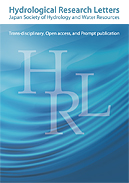Volume 11, Issue 2
Displaying 1-7 of 7 articles from this issue
- |<
- <
- 1
- >
- >|
Original Research Letter
-
2017Volume 11Issue 2 Pages 92-98
Published: January 01, 2017
Released on J-STAGE: April 07, 2017
Download PDF (9847K) -
2017Volume 11Issue 2 Pages 99-105
Published: 2017
Released on J-STAGE: April 28, 2017
Download PDF (10396K) -
2017Volume 11Issue 2 Pages 106-113
Published: 2017
Released on J-STAGE: May 16, 2017
Download PDF (7393K) -
2017Volume 11Issue 2 Pages 114-120
Published: 2017
Released on J-STAGE: May 19, 2017
Download PDF (9998K) -
2017Volume 11Issue 2 Pages 121-127
Published: 2017
Released on J-STAGE: May 25, 2017
Download PDF (2295K) -
2017Volume 11Issue 2 Pages 128-133
Published: 2017
Released on J-STAGE: June 21, 2017
Download PDF (1301K) -
Impact of rice cultivation on evapotranspiration in small seasonal wetlands of north-central Namibia2017Volume 11Issue 2 Pages 134-140
Published: 2017
Released on J-STAGE: June 22, 2017
Download PDF (2503K)
- |<
- <
- 1
- >
- >|
